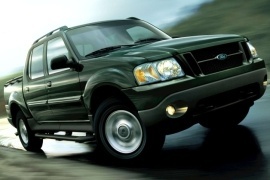
FORD Explorer Sport Trac
Generations Timeline, Specs and Pictures

The American carmaker noticed that the customers with an active lifestyle want a pickup that won’t handle like a truck, and they won’t use it like one either, so it gave them the Explorer Sport Trac.
Ford already had the F150 double cab on the offer for ages when the Explorer Sport Trac was introduced in 2000. But unlike the well-known workhorse, the new vehicle had another purpose. It was built for comfort and a bed in the back to carry camping gear and, maybe, one or two bikes, but not a one-ton heavy load as its hard-working F-Series. The second generation was introduced in 2006 as a 2007 model, with an important upgrade on the platform and look.
The Explorer Sport Trac kept the same front fascia as the regular Explorer, with rectangular headlights that cut into the front bumper from the outside. Depending on the trim level, the grille was in body color or chromed.
Inside, Ford focused on comfort features. Due to its longer wheelbase than the regular Explorer, it offered better legroom for all passengers. Like its predecessor, the 2007 model featured a power-retractable rear window. The designers installed the gear selector for the automatic transmission on the center console, not behind the steering wheel. Thus, they created a car-like feeling.
Under the hood, Ford installed the same 4.0-liter V6 from its predecessor, but it introduced a new 4.6-liter V8 unit as an option. The engineers added more comfort for the passengers by introducing an independent rear suspension, while the F150 retained its live-axle.

In 2000, Ford introduced the Explorer Sport Trac as an Explorer-based pickup-truck on the U.S. market for those looking for a leisure utility vehicle.
While the Ford F150 remained the best selling vehicle in the world, Ford noticed that the customers started to look for less hard-working vehicles to tow their boats or trailers to the camping areas. Vehicles such as Honda Ridgeline, Nissan Frontier, or Toyota Tacoma were already on the market and started to steal Ford’s customers. The Sport Trac was based on the same platform as the Explorer and shared most of its comfort features.
Less-rugged, softer on the edges, and with plastic overfenders, the Explorer Sport Trac was one of the vehicles that stood apart from Ford’s lineup. Unlike the F-Series, which featured a quarter panel that started behind the rear doors and ended behind the car, the Sport Trac sported a distinct bed. The front side, up to the C-pillars, resembled the Explorer lineup with similar headlights, doors, and windows.
Inside, Ford installed a car-like dashboard with soft lines and curved lines over the instrument cluster. Its white dials resembled sports cars, even though it featured more gauges than a regular street vehicle. On top of the center stack, the design team installed two air-vents and underneath them the CD-Stereo. Ford offered two bucket-seats at the front and a split-folding bench in the rear.
Under the hood, Ford installed the same powertrains from the Explorer, with a 4.0-liter V6 as the base version, while the 4.6-liter V8 was offered for those in a hurry or with a boat attached behind.























































